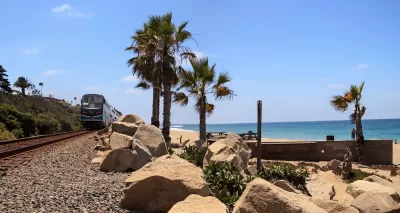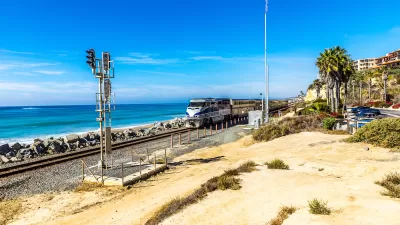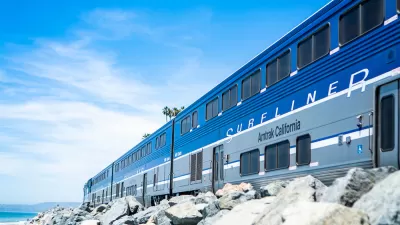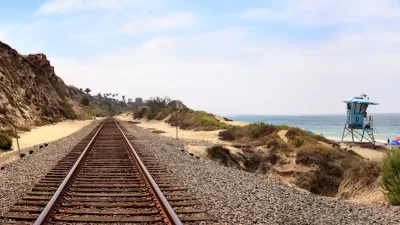Coastal erosion and rising sea levels threaten one of the nation’s most scenic—and strategically important—rail corridors.

The coastal rail corridor between San Diego and Santa Barbara faces growing risks from coastal erosion and climate change, according to a California Senate Transportation Subcommittee. As Phil Diehl explains in The San Diego Union-Tribune, “Landslides and cliff collapses have periodically stopped the trains in Del Mar and San Clemente, and many other places also need improvements and protection from sea-level rise along the 351-mile Los Angeles-San Diego-San Luis Obispo corridor.” Yet the corridor provides a crucial transportation link for passengers, freight, and military transportation.
According to a Senate report, the cost of making safety improvements to the Los Angeles-San Diego-San Luis Obispo (LOSSAN) corridor could be more than $20 billion. With seven different right-of-way owners, the corridor is a complex system with little precedent in the United States. Researcher Genvieve Giuliano says a long-term solution would be “to create a single statewide agency that would fully integrate the multiple agencies that provide the separate passenger services — Amtrak, Coaster and Metrolink.”
Farther up the coast, the state’s Department of Transportation (Caltrans) recently completed its first erosion mitigation project for a roadway, moving a highway segment 400 feet to protect it from landslides.
FULL STORY: Climate change imperils San Diego County’s coastal rail corridor, panelists say

Trump Administration Could Effectively End Housing Voucher Program
Federal officials are eyeing major cuts to the Section 8 program that helps millions of low-income households pay rent.

Planetizen Federal Action Tracker
A weekly monitor of how Trump’s orders and actions are impacting planners and planning in America.

Ken Jennings Launches Transit Web Series
The Jeopardy champ wants you to ride public transit.

Congress Moves to End Reconnecting Communities and Related Grants
The House Transportation and Infrastructure Committee moved to rescind funding for the Neighborhood Equity and Access program, which funds highway removals, freeway caps, transit projects, pedestrian infrastructure, and more.

From Throughway to Public Space: Taking Back the American Street
How the Covid-19 pandemic taught us new ways to reclaim city streets from cars.

Opinion: Transit Agencies Must View Service Cuts as Last Resort
Reducing service could cripple transit systems by pushing more riders to consider car ownership, making future recovery even less certain.
Urban Design for Planners 1: Software Tools
This six-course series explores essential urban design concepts using open source software and equips planners with the tools they need to participate fully in the urban design process.
Planning for Universal Design
Learn the tools for implementing Universal Design in planning regulations.
Heyer Gruel & Associates PA
Ada County Highway District
Institute for Housing and Urban Development Studies (IHS)
City of Grandview
Harvard GSD Executive Education
Toledo-Lucas County Plan Commissions
Salt Lake City
NYU Wagner Graduate School of Public Service





























